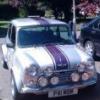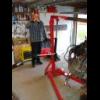
Building A Homemade Spray Booth
#16

Posted 12 June 2012 - 11:20 PM
#17

Posted 13 June 2012 - 08:48 AM
im not sure on whether you would need some kind of filter on the extraction you use to filter out the toxins but i guess just the one car in a home made booth could be okay? (dont quoute me on this i dont know)
it is also suggested that an airfed mask is used... which is obviously a good idea to avoid problems, 2pac as i understand can be quite dangerous if the proper precausions are not taken... so if you do spray it and use just a fan it will blow all the toxic stuff all round ur friends and family and neighbours so probably unadvisable??
any one confirm the above??^
#18

Posted 13 June 2012 - 11:06 AM
#19

Posted 14 June 2012 - 11:37 AM
It is a bit silly compressing air to maybe 80 psi, when you need to breathe it at atmospheric pressure. I have been wondering if the compressor from a HVLP gun would do the breathing air bit? Only snag is that they use something large like vacuum cleaner hose to shift the volume of air.
I am planning ahead for when I need to do this, and there are many snags. I can't see how to avoid poisoning the neighbours, for a start. Do you have to exhaust the air up a tall stack, and only spray on a windy day, so it disperses?
Another point to watch is that most paints, or their thinners, are highly inflammable. You really don't want to operate any electrical switches in there, and the fan motors need to be brushless so there is no sparking, if they are sucking air out. It may not be so important if they are only blowing clean air in.
How do you filter the incoming air to keep dust off your fresh paint? Maybe some large vacuum cleaner filters?
I think we need input from experts on the subject, who actually know how to build spray booths. We don't need permanent structures like the professionals, but we do need the same safety features.
#20

Posted 14 June 2012 - 01:35 PM
#21

Posted 14 June 2012 - 06:16 PM
By the way, I really would like to find a safe way of using 2 pack at home, and am not against the idea. I just don't like people killing themselves. If someone comes up with a safe way of doing it, I am all in favour.
Edited by tiger99, 14 June 2012 - 06:18 PM.
#22

Posted 14 June 2012 - 06:56 PM
Just to confirm, you absolutely MUST use an air-fed mask, and the compressor which is supplying the mask air must be taking in air from somewhere that the isocyanate fumes don't go. Arranging all that would not be easy. Even getting breathable air from a compressor is not trivial, there tends to be some oil, which can seriously damage the lungs, and you will need a large compressor to supply sufficient volume. Basically two compressors, one for you, the other for the gun. If you try to rely on a filter mask, you will die. They don't work, except for dust, and even then they have limitations, like letting asbestos straight through.
It is a bit silly compressing air to maybe 80 psi, when you need to breathe it at atmospheric pressure. I have been wondering if the compressor from a HVLP gun would do the breathing air bit? Only snag is that they use something large like vacuum cleaner hose to shift the volume of air.
I am planning ahead for when I need to do this, and there are many snags. I can't see how to avoid poisoning the neighbours, for a start. Do you have to exhaust the air up a tall stack, and only spray on a windy day, so it disperses?
Another point to watch is that most paints, or their thinners, are highly inflammable. You really don't want to operate any electrical switches in there, and the fan motors need to be brushless so there is no sparking, if they are sucking air out. It may not be so important if they are only blowing clean air in.
How do you filter the incoming air to keep dust off your fresh paint? Maybe some large vacuum cleaner filters?
I think we need input from experts on the subject, who actually know how to build spray booths. We don't need permanent structures like the professionals, but we do need the same safety features.
I think the above comment is abit strong. While you have made some VERY useful comments about H&S issues.
I know a few people that have sprayed various items ranging from alloys to a whole car with 2 pack using a filter mask and felt fine afterwards. Now ofcourse other health issues have a play aswell (i.e asthma etc)
Health issues could arise in the future but thats inpossible to tell.
When I spray 2 pack I will be using a filter mask, along with covering all skin etc.
#23

Posted 14 June 2012 - 06:59 PM
#24

Posted 15 June 2012 - 03:35 PM
In my industry (Aviation) we have a mask for virtually every occasion and it can be baffling to say the least. From standard dust masks, to double filter vapour masks, fume masks, forced air masks and so on.
I think to be safe then you cannot go wrong with proper air fed masks but unless you have all of the associated equipment to go with it then as Tiger has mentioned there can be pitfalls using that as well.
You can get a really good finish with celly without the major risks associated with 2K products but again you need to be careful about extraction and of course your own breathing requirements. H&S is a pain in the backside but it has brought to light the amount of damage we are doing to ourselves with a lot of items we have taken for granted over the years. Old engine oil (carcinogenic) filler dust, old brake linings (not the newer types) and of course paint.
So with all of that i'm doomed and now just waiting for my skin to fall off and my head to explode. But it was good while it lasted
#25

Posted 18 June 2012 - 04:22 PM
Mat
#26

Posted 19 June 2012 - 05:21 PM
I'm an engineer in a paint plant where we spray vehicle parts up to semi-shells. I help build the booths, I maintain them and I used to work as a sprayer.
Our air fed masks are fed from the same feed as the spray guns which are on a 80lbspsi line, which is filtered 3 times to remove any oil or moisture. Yes, the air is 'compressed' as someone posted earlier, but you don't squirt it directly into your lungs! The air fed mask leaks and is also fed at relatively low volume. A simply clamp regulator works wonders. The air surrounds your face within the mask and you breathe what you need; it's not pressurised.
We have a large customer base which spans pretty much every car manufacturer globally, and apart from Aston Martin, all of them have spoilers and bumpers which use a simple 2k primer, water-based basecoat and then a 2k clearcoat. Just using Ford as an example, every Ka, Fiesta, Mondeo, Focus, Edge, Kuga, Fusion S-Max, C-Max, ST and RS has our panels and they're all sprayed in the same way.
Each booth has water-walls and floor with 6 point extraction which draws overspray down around the parts and up into filter banks. Everyone wears air-fed masks apart from the Mixers who are only in the booths for a couple of minutes, and they wear special canister masks. Anyone who has sprayed in their garage without protection and says "didn't do me any harm" should see some people who have worked in the industry for a few years. Even with protection, we have very high rates of cancer, heart and lung disease.
Isocyanates kill. Fact. You can die slowly through small but long-term exposure or die instantly if you get one, yes ONE, good lungfull at as little as 4 parts per million. We don't f*ck about with it at work because we have had deaths in the plant.
The booth above made out of plastic is great.
Wet the plastic walls down to remove dust and keep the floor wet and you'll eliminate a lot of inclusions.
A decent fan like an old Expelair in one side to suck the overspray out is essential, but don't forget to have an air feed too. The extraction fan will only keep overspray away if you maintain a positive air pressure in the booth; it's a bit like electricity and takes the path of least resistance. If you help keep it airborne, it will, then you can suck it away.
Hope all that helps in some way.
Sorry to blow on so much, but at least it's real info using facts and from someone who works with it every day.
P.S. Remember to wear disposable overalls too with a plasticised outer shell because the paint is also absorbed through the skin. In a homemade booth you could get away with a set of 3M whites and a canister mask, but you would have to have minimal exposure time. For about £180, this thing could save your life:

Edited by Geomorphologist, 19 June 2012 - 05:33 PM.
#27

Posted 19 June 2012 - 05:33 PM
Hi, just to add a few comments about the 'dangers of 2K' and air fed masks...
I'm an engineer in a paint plant where we spray vehicle parts up to semi-shells. I help build the booths, I maintain them and I used to work as a sprayer.
Our air fed masks are fed from the same feed as the spray guns which are on a 80lbspsi line, which is filtered 3 times to remove any oil or moisture. Yes, the air is 'compressed' as someone posted earlier, but you don't squirt it directly into your lungs! The air fed mask leaks and is also fed at relatively low volume. A simply clamp regulator works wonders. The air surrounds your face within the mask and you breathe what you need; it's not pressurised.
We have a large customer base which spans pretty much every car manufacturer globally, and apart from Aston Martin, all of them have spoilers and bumpers which use a simple 2k primer, water-based basecoat and then a 2k clearcoat. Just using Ford as an example, every Ka, Fiesta, Mondeo, Focus, Edge, Kuga, Fusion S-Max, C-Max, ST and RS has our panels and they're all sprayed in the same way.
Each booth has water-walls and floor with 6 point extraction which draws overspray down around the parts and up into filter banks. Everyone wears air-fed masks apart from the Mixers who are only in the booths for a couple of minutes, and they wear special canister masks. Anyone who has sprayed in their garage without protection and says "didn't do me any harm" should see some people who have worked in the industry for a few years. Even with protection, we have very high rates of cancer, heart and lung disease.
Isocyanates kill. Fact. You can die slowly through small but long-term exposure or die instantly if you get one, yes ONE, good lungfull at as little as 4 parts per million. We don't f*ck about with it at work because we have had deaths in the plant.
The booth above made out of plastic is great.
Wet the plastic walls down to remove dust and keep the floor wet and you'll eliminate a lot of inclusions.
A decent fan like an old Expelair in one side to suck the overspray out is essential, but don't forget to have an air feed too. The extraction fan will only keep overspray away if you maintain a positive air pressure in the booth; it's a bit like electricity and takes the path of least resistance. If you help keep it airborne, it will, then you can suck it away.
Hope all that helps in some way.
Sorry to blow on so much, but at least it's real info using facts and from someone who works with it every day.
JUST what we needed.
I think it was mentioned that we needed someone that worked in the trade to put there input in.
Thanks
#28

Posted 19 June 2012 - 05:42 PM
Thanks Tom. I was trying not to blow on too much, but...JUST what we needed.
I think it was mentioned that we needed someone that worked in the trade to put there input in.
Thanks
#29

Posted 19 June 2012 - 06:10 PM
Thanks for that very useful info, which may avoid a few people killing themselves or at least ruining their health. One of these days I may well want to spray 2 pack myself. I must admit I had forgotten about the possibility of absorption through the skin.
I was not suggesting that anyone would breathe air at above atmospheric pressure, just that it was silly (if it could be avoided) to compress it just to move it around and return it to atmospheric pressure. It is a waste of energy. On the other hand, if you have a decent compressor setup, as you describe, it makes sense, because it is easy. Most people spraying in their domestic garage may not be able to do it all with one compressor.
#30

Posted 20 June 2012 - 06:43 AM
For the domestic user, a very effective means of getting more out of a small compressor is to go to the local scrappy and find and old air taink, or more commonly a pair, from an old bus or small wagon. When plumbed in series they act as a great accumulator after the standard air tank.
Make a simple three way manifold (or if you can't, ask me to make one when I'm on nights!) and you can run your spray gun, mask and gauge from a hobby compressor that way.
Before I could afford decent kit, it was exactly the setup I had.
I shudder to think about the safety side of things and what I've done to myself over the years. No doubt I'll get to 'reap the benefits' of it all later...
Remember when we all sprayed cellulose with constant bleed guns? 1 part car, 1 part you, 2 parts in the air for both!
1 user(s) are reading this topic
0 members, 1 guests, 0 anonymous users















